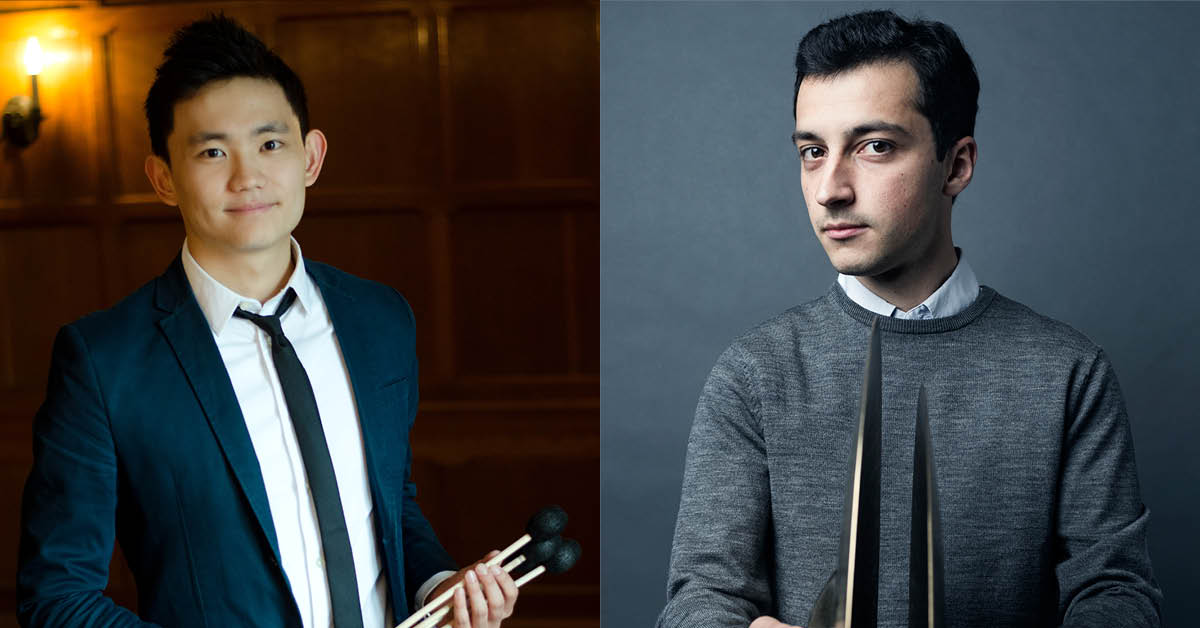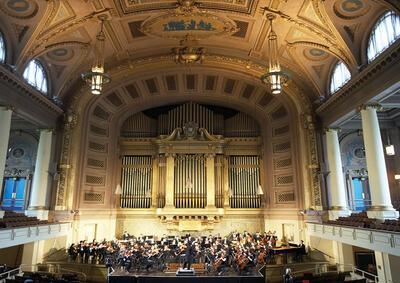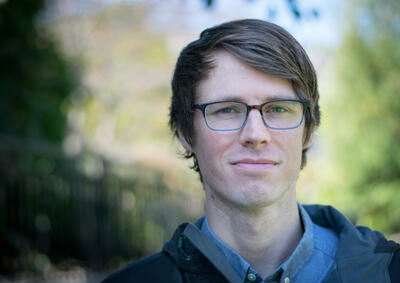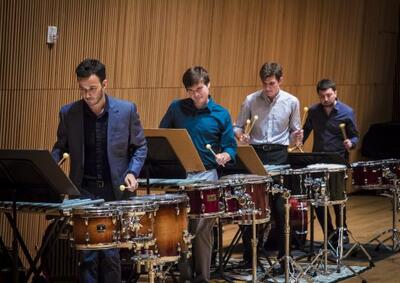YSM percussionists to perform faculty composer's double marimba concerto
On Friday, October 27, percussionists and Woolsey Hall Concerto Competition winners Sam Um '17MM ’18MMA and Georgi Videnov ’15MM ’17MMA will perform YSM faculty composer Martin Bresnick's concerto for two marimbas, Grace, with principal conductor Peter Oundjian and the Yale Philharmonia. We spoke recently with Sam and Georgi about preparing and performing Bresnick's concerto.
Q: Grace was composed in 2000 for Yale Percussion Group Director Robert van Sice. How has working with Prof. van Sice informed your approach to the concerto? Has the piece changed at all since Prof. van Sice first performed it?
Um: Working with Prof. van Sice is always an exciting and illuminating experience. From the stories of how this piece came to life to his experiences of playing this piece in various places in the world, those stories influenced a lot of perspective and gave us more of a sense of attachment to the piece.
Videnov: In the case of Grace, Prof. van Sice usually uses it as a teaching tool by playing the first marimba part himself and giving the other to a student. This time, by working on it from the outside, he focused our attention on issues such as balance, stylistic approach, and interpretation. Even though the piece itself hasn’t changed, I believe that the relationship between each of the performers creates a unique version of it every time it’s played.
Q: Have you talked at all with Prof. Bresnick about the piece and, if so, what have those conversations yielded?
Videnov: Sam and I had the pleasure of playing it for Prof. Bresnick in a coaching and during my recital. One of the important aspects for him was to differentiate the “roles” of the two soloists -- such as there is clearly a puppeteer and a puppet -- as Heinrich von Kleist reflects on this relationship in his essay The Puppet Theatre.
um: Prof. Bresnick and Prof. van Sice’s attention to the sound of the instrument was crucial in our process because we came to realize that the sound world of this piece is just so beautiful and complex. The idea of echo, nostalgia, and groove made us view the piece in an entirely different way.
Q: What unique aspects of the instrument and mallet technique does the piece exploit?
Videnov: The piece exploits a number of techniques utilizing the entire five-octave range of the marimba. In its climactic points, Sam plays in the low register of the instrument, while I cover its high register, allowing the marimba to express its sonorous qualities to its fullest potential. What I find particularly interesting is the interlocking gestures that both marimbas have between each other to create a continuous texture.
Um: In order to achieve a huge sound without being aggressive requires a mature approach to the instrument. Trying to find that balance of making it sound weighty was a special technique, which was very challenging.
Q: What are the most challenging aspects (either technically or musically) of the piece? And what are the challenges of performing the piece with an orchestra?
Videnov: Due to its nature and the fact that we fill each other’s rests, it is almost harder to play and practice the piece on your own. Early on in the process, Sam and I started rehearsing it together before we even had fully mastered our individual parts to get a sense of how it fits together.
Um: Again, the sound has to be one of the most challenging parts about this piece. To create the beautiful texture and to almost tag-team with different groups of instruments to become one super-instrument will be challenging.
Q: How have you gone about ensuring a consistency of sound and color (between you)?
Um: We did lot of counting work and breathing together whenever we had entrances together. With such responsive instruments like percussion, we have to focus a lot on each other’s ictus and try to match our strokes. In the third movement, where we have passing, flowing lines, we sang those lines out loud to match our dynamics and tempi.
Videnov: The marimbas are set up in such a way (facing each other) that allows us to constantly check in with each other, both visually and aurally, on our sound and color. As Sam mentioned, we are quite aware of our stroke preparations and how we feel the groove, both when we are playing and when we have rests.
Q: How would you introduce the piece to audiences who might be new to marimba concerti and even to contemporary music?
Videnov: Despite the fact that the marimba has found its place in the contemporary solo concerto repertoire, the choices for a double marimba concerto are quite limited. Here is an example that doesn’t try to impress with virtuosity (even though it requires such), but with grace.
SU: I’d love to say that just because it’s new music, it’s not all complicated and difficult to listen to. Contemporary composers are mostly influenced by great musicians people are familiar with such as Bach, Beethoven, and Brahms, and they all share the same vision of making music important in their culture. I strongly believe that experiencing and being exposed to new music can be beautiful, nostalgic, and heartwarming, as well.
Q: What are your thoughts about performing a concerto by a YSM faculty composer here, at YSM, with an orchestra of your peers?
Videnov: Even though I’d like to share this piece with audiences outside of YSM in the future, I don’t think there is a better place for it than where the piece was conceived and having the opportunity to work on it with our professors and Maestro Oundjian -- especially at Yale’s Woolsey Hall!
Um: I am very happy to have this opportunity where we can perform a piece by Martin Bresnick, who is undoubtedly one of the greatest composers and pioneers of today’s music. And to say that I am part of the same community (YSM) as him defines the great experience that students can have here at Yale. Performing this concerto has become so much more than giving a great concert. As percussionists, we unkowningly become ambassadors of new music and percussion. With this concert, I hope that we’ll be able to soften some opinions and break any barriers and fears that people have toward new music. I am grateful to be a part of the Yale School of Music, where the School provides its full support for the new music scene with concert series and opportunities like this.
Principal conductor Peter Oundjian and the Yale Philharmonia will perform in Woolsey Hall on Friday, October 27, at 7:30 pm. The program features the world premiere of the International Bruckner Society’s new edition of the composer’s Eighth Symphony, which was created by Yale School of Music Professor of Musicology and International Bruckner Society editorial board member Paul Hawkshaw. Special offer: tickets are free for all students.






